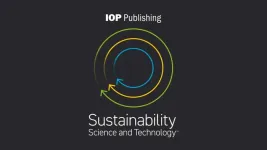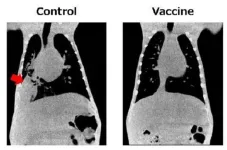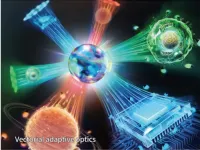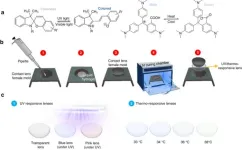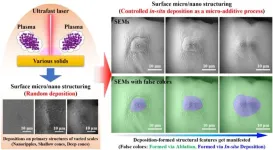(Press-News.org) Statement Highlights:
Intensive care management of cardiac arrest survivors is important and influences survival and neurological outcomes.
This collaborative statement from a diverse group with expertise in post-cardiac arrest care identifies current knowledge gaps and provides guidance about care in topics where research and existing guidelines were not able to provide solid evidence.
This statement calls for more research into neurological, cardiac, pulmonary, hematologic, infectious, gastrointestinal, endocrine and general critical care management after cardiac arrest.
Embargoed until 4 a.m. CT / 5 a.m. ET Tuesday, Nov. 28, 2023
DALLAS, Nov. 28, 2023 — A new consensus statement from the American Heart Association Emergency and Cardiovascular Care Committee and the Neurocritical Care Society calls for more research to address areas of post-cardiac arrest care that have limited research. The statement published today simultaneously in the Association’s flagship journal Circulation and in Neurocritical Care, the Neurocritical Care Society’s journal.
Cardiac arrest affects over 600,000 people in the United States annually, with a worldwide annual incidence of 30 to 97 individuals per 100,000 population.[1]
While guidelines address some relevant topics based on large bodies of scientific evidence, like temperature control and neurological prognostication, many important subject areas have less evidence to support practice or to be included in guidelines. A scientific statement is an expert analysis of current research and may inform future clinical practice guidelines.
In this scientific statement, the consensus panel outlines suggestions to address the following topics in post-cardiac arrest care: neurological, cardiac, pulmonary, hematologic, infectious, gastrointestinal, endocrine and general critical care management.
“This is not just a heart, brain or lung problem, this is a whole-body problem,” said Romergryko G. Geocadin, M.D., professor of neurology at Johns Hopkins Hospital and chair of the writing committee. “After they resuscitate, many professionals think they’ve done their job, however, there’s much more to do after that moment, and it should be a more cohesive team providing care from there on.”
The expert panel categorized the needs for future research by body system, and concluded:
Neurological management in the Intensive Care Unit (ICU) includes future research considerations for the use of advanced seizure monitoring techniques, and the influence of analgesic, sedative and neuromuscular blockade agents.
Cardiac management in the ICU includes hemodynamics, monitoring and mechanical circulatory support, and considerations for timing and appropriateness of cardiac catheterization.
Pulmonary and hematologic management in the ICU needs future research on the impact of oxygenation and ventilation on all organs, and studies on the safety and efficacy of early thromboprophylaxis in patients after cardiac arrest are warranted.
Additional system and disease management in the ICU includes digestive system management, infectious disease management and endocrine and fluids management. Management of these systems and diseases is an important aspect of critical care management, and future research is needed.
“Until high-quality studies that inform practice guidelines in these areas are available, we hope this statement will help further advise clinicians on the critical care management of patients after cardiac arrest,” said Karen G. Hirsch, M.D., associate professor of neurology and neurosurgery at Stanford University and co-chair of the writing committee.
This scientific statement was prepared by the volunteer writing group on behalf of the American Heart Association and the Neurocritical Care Society. American Heart Association scientific statements promote greater awareness about cardiovascular diseases and stroke issues and help facilitate informed health care decisions. Scientific Statements outline what is currently known about a topic, and what areas need additional research. While scientific statements inform the development of guidelines, they do not make treatment recommendations. American Heart Association guidelines provide the Association’s official clinical practice recommendations.
Additional writing group members include: Benjamin S. Abella, M.D., M.Phil., FAHA; Edilberto Amorim, M.D.; Mary Kay Bader, R.N., M.S.N., FAHA; Jeffrey F. Barletta, Pharm.D.; Katherine Berg, M.D.; Clifton W. Callaway, M.D., Ph.D., FAHA; Hans Friberg, M.D., Ph.D.; Emily J. Gilmore, M.D.; David M. Greer, M.D., FAHA; Karl B. Kern, M.D., FAHA; Sarah Livesay, D.N.P., R.N.; Teresa L. May, D.O.; Robert W. Neumar, M.D., Ph.D., FAHA; Jerry P. Nolan, M.D.; Mauro Oddo, M.D.; Mary Ann Peberdy, M.D., FAHA; Samuel M. Poloyac, Pharm.D., Ph.D.; David Seder, M.D., FAHA; Fabio Silvio Taccone, M.D., Ph.D.; Anezi Uzendu, M.D.; Brian Walsh, Ph.D., R.R.T.; and Janice L. Zimmerman, M.D. Disclosures are listed in the manuscript.
The Association receives funding primarily from individuals. Foundations and corporations (including pharmaceutical, device manufacturers and other companies) also make donations and fund specific Association programs and events. The Association has strict policies to prevent these relationships from influencing the science content. Revenues from pharmaceutical and biotech companies, device manufacturers and health insurance providers and the Association’s overall financial information are available here.
Additional Resources:
Multimedia is available in the right column of the release https://newsroom.heart.org/news/critical-care-of-patients-after-cardiac-arrest-is-crucial-needs-more-research?preview=a8d408134c7c44f8f494475f05e4bcf5
Link to full study
AHA health information: Resuscitation Science
AHA cardiac arrest initiative: Join the Nation of Lifesavers
AHA Hands-Only CPR training: Hands-Only CPR video
###
About the American Heart Association
The American Heart Association is a relentless force for a world of longer, healthier lives. We are dedicated to ensuring equitable health in all communities. Through collaboration with numerous organizations, and powered by millions of volunteers, we fund innovative research, advocate for the public’s health and share lifesaving resources. The Dallas-based organization has been a leading source of health information for nearly a century. Connect with us on heart.org, Facebook, X or by calling 1-800-AHA-USA1.
About the Neurocritical Care Society
The Neurocritical Care Society (NCS) is proud to be the only professional society representing multi-disciplinary teams of neurocritical care providers around the world whose mission is to improve outcomes for patients with life-threatening neurological illnesses. The NCS community includes more than 3,000 neurocritical care providers from 50 different countries. For more information about the NCS, visit www.neurocriticalcare.org.
For Media Inquiries:
American Heart Association: Sarah D. Williams, sarah.d.williams@heart.org
Neurocritical Care Society: Kat Seiffert, kseiffert@neurocriticalcare.org
For Public Inquiries: 1-800-AHA-USA1 (242-8721)
heart.org and stroke.org
[1] Virani SS, Alonso A, Benjamin EJ, Bittencourt MS, Callaway CW, Carson AP, Chamberlain AM, Chang AR, Cheng S, Delling FN, et al; on behalf of the American Heart Association Council on Epidemiology and Prevention Statistics Committee and Stroke Statistics Subcommittee. Heart disease and stroke statistics—2020 update: a report from the American Heart Association. Circulation. 2020;141:e139–e596. doi: 10.1161/CIR.0000000000000757
Kiguchi T, Okubo M, Nishiyama C, Maconochie I, Ong MEH, Kern KB, Wyckoff MH, McNally B, Christensen EF, Tjelmeland I, et al. Out-of-hospital cardiac arrest across the world: first report from the International Liaison Committee on Resuscitation (ILCOR). Resuscitation. 2020;152:39–49. doi: 10.1016/j.resuscitation.2020.02.044
Tsao CW, Aday AW, Almarzooq ZI, Alonso A, Beaton AZ, Bittencourt MS, Boehme AK, Buxton AE, Carson AP, Commodore-Mensah Y, et al; on behalf of the American Heart Association Council on Epidemiology and Prevention Statistics Committee and Stroke Statistics Subcommittee. Heart disease and stroke statistics—2022 update: a report from the American Heart Association [published correction appears in Circulation. 2022;146:e141]. Circulation. 2022;145:e153–e639. doi: 10.1161/CIR.0000000000001052
END
Critical care of patients after cardiac arrest is crucial, needs more research
A new Scientific Statement from the American Heart Association and the Neurocritical Care Society addresses gaps in knowledge about intensive care after cardiac arrest
2023-11-28
ELSE PRESS RELEASES FROM THIS DATE:
Proposals for an efficient and effective corporate sustainability due diligence in Europe
2023-11-28
The Supply Chain Intelligence Institute Austria (ASCII) advocates for a revision of the EU Corporate Sustainable Due Diligence Directive (CS3D). The proposed amendments focus on direct monitoring of suppliers – instead of bilateral supply links – and the introduction of negative and positive lists to streamline due diligence processes, improving effectiveness and reducing costs for EU importers.
The Corporate Sustainability Due Diligence Directive (CS3D), currently under negotiation by EU institutions with a potential adoption in 2024, aligns with international norms to cover both human rights and environmental ...
IOP Publishing launches Sustainability Science and Technology – a new interdisciplinary OA journal aimed at fostering a sustainable future
2023-11-28
IOP Publishing (IOPP) is launching Sustainability Science and Technology, an interdisciplinary, open access journal dedicated to advancing sustainability through cutting-edge research in science, technology, and engineering. The new journal will bring together researchers from diverse disciplines across engineering, chemistry, physics, materials science and environmental science to address global challenges and contribute to a more sustainable future.
Sustainability Science and Technology sets itself apart by focussing on the critical importance of sustainable impact. ...
Female toxin-producing newts are surprisingly more poisonous than males
2023-11-28
Tetrodotoxin, the neurotoxin that makes a blue-ringed octopus deadly, also protects Taricha newts — but we don’t understand how they produce it, or what purposes it serves for them. A first step to answering these questions is understanding whether different levels appear in males and females. In sexually reproducing animals, dimorphic traits such as color or canine tooth size can be key for survival and reproductive fitness. Investigating whether toxin production is a sexually dimorphic trait in newts gets us closer to understanding it.
“It had long been considered that newts’ ...
Macaque trials offer hope in pneumonia vaccine development
2023-11-28
Osaka, Japan – The global impact of the coronavirus pandemic has ignited a renewed focus on emerging and re-emerging infectious diseases. Researchers at Osaka Metropolitan University are making great strides in combating pneumococcal pneumonia, one of the leading causes of respiratory deaths worldwide.
Despite the existence of vaccines against pneumococcal infections such as otitis media, sinusitis, and meningitis, the prevalence of pneumococcal pneumonia remains high. Currently, around 100 new serotypes of Streptococcus pneumoniae have been identified, and ...
Nextgen computing: Hard-to-move quasiparticles glide up pyramid edges
2023-11-28
Image
A new kind of "wire" for moving excitons, developed at the University of Michigan, could help enable a new class of devices, perhaps including room temperature quantum computers.
What's more, the team observed a dramatic violation of Einstein's relation, used to describe how particles spread out in space, and leveraged it to move excitons in much smaller packages than previously possible.
"Nature uses excitons in photosynthesis. We use excitons in OLED displays and some LEDs and solar cells," said Parag Deotare, ...
Unlocking the secrets of cells with AI
2023-11-28
Machine learning is now helping researchers analyze the makeup of unfamiliar cells, which could lead to more personalized medicine in the treatment of cancer and other serious diseases.
Researchers at the University of Waterloo developed GraphNovo, a new program that provides a more accurate understanding of the peptide sequences in cells. Peptides are chains of amino acids within cells and are building blocks as important and unique as DNA or RNA.
In a healthy person, the immune system can correctly identify the peptides of irregular or foreign cells, such as cancer cells or harmful bacteria, and then target those cells for destruction. For people whose immune system is ...
Vectorial adaptive optics: correcting both polarization and phase
2023-11-28
Adaptive optics (AO) is a technique used for real-time correction of phase aberrations by employing feedback to adjust the optical system. Polarization aberrations represent another significant type of distortion that can impact optical systems. Various factors, such as stressed optical elements, Fresnel effects, and polarizing effects in materials or biological tissues, can induce polarization aberrations. These aberrations affect both system resolution and the accuracy of vector information.
Vectorial aberrations result from the ...
Contact lenses developed by Khalifa University team respond to UV and temperature changes
2023-11-28
The global rise in ocular diseases, largely due to insufficient ophthalmic diagnostics and monitoring, has emphasized the need for better treatment methods. Pioneering developments in therapeutic and diagnostic contact lenses are now offering hope in treating these diseases.
Cataracts, which cloud the lens of the eye, are a prime example, affecting 94 million people and leading to 10 million surgeries annually. A significant factor in the rise of cataracts and other ocular conditions, such as age-related macular degeneration (AMD) and photokeratitis, is excessive exposure to ultraviolet (UV) light.
In response, a team of researchers at Khalifa University has ...
Gaining more control over the fabrication of surface micro/nano structures using ultrafast lasers
2023-11-28
Surface functionalization via micro/nano structuring is not only a thriving research area inspired by bionics but also of great importance for various practical applications. The key to achieving various surface functions is the fabrication of surface micro/nano structures with controlled dimensions, hierarchies, and compositions, which is driving the continuous progress of micro/nano fabrication techniques. Researchers from the Laser Materials Processing Research Center at the School of Materials Science and Engineering of Tsinghua University, China, have spent years in developing laser-enabled fabrication ...
Call for papers
2023-11-28
1 Overview
A number of open source resources, in the form of curated datasets, web-based databases, stand-alone software, or library packages have been floating in various forms online. These codes are useful in computer science research works, and engineering practices. The application of these resources requires instructions. Traditional scientific publications usually focus on the algorithms, principles, theoretical proofs, benchmarking evaluations and comparisons that is in the background or in the generation process of these resources. The instructions, case studies, application examples and sample codes, which help users and other practitioners to utilize these ...
LAST 30 PRESS RELEASES:
Numbers in our sights affect how we perceive space
SIMJ announces global collaborative book project in commemoration of its 75th anniversary
Air pollution exposure and birth weight
Obstructive sleep apnea risk and mental health conditions among older adults
How talking slows eye movements behind the wheel
The Ceramic Society of Japan’s Oxoate Ceramics Research Association launches new international book project
Heart-brain connection: international study reveals the role of the vagus nerve in keeping the heart young
Researchers identify Rb1 as a predictive biomarker for a new therapeutic strategy in some breast cancers
Survey reveals ethical gaps slowing AI adoption in pediatric surgery
Stimulant ADHD medications work differently than thought
AI overestimates how smart people are, according to HSE economists
HSE researchers create genome-wide map of quadruplexes
Scientists boost cell "powerhouses" to burn more calories
Automatic label checking: The missing step in making reliable medical AI
Low daily alcohol intake linked to 50% heightened mouth cancer risk in India
American Meteorological Society announces Rick Spinrad as 2026 President-Elect
Biomass-based carbon capture spotlighted in newly released global climate webinar recording
Illuminating invisible nano pollutants: advanced bioimaging tracks the full journey of emerging nanoscale contaminants in living systems
How does age affect recovery from spinal cord injury?
Novel AI tool offers prognosis for patients with head and neck cancer
Fathers’ microplastic exposure tied to their children’s metabolic problems
Research validates laboratory model for studying high-grade serous ovarian cancer
SIR 2026 delivers transformative breakthroughs in minimally invasive medicine to improve patient care
Stem Cell Reports most downloaded papers of 2025 highlight the breadth and impact of stem cell research
Oxford-led study estimates NHS spends around 3% of its primary and secondary care budget on the health impacts of heat and cold in England
A researcher’s long quest leads to a smart composite breakthrough
Urban wild bees act as “microbial sensors” of city health.
New study finds where you live affects recovery after a hip fracture
Forecasting the impact of fully automated vehicle adoption on US road traffic injuries
Alcohol-related hospitalizations from 2016 to 2022
[Press-News.org] Critical care of patients after cardiac arrest is crucial, needs more researchA new Scientific Statement from the American Heart Association and the Neurocritical Care Society addresses gaps in knowledge about intensive care after cardiac arrest
